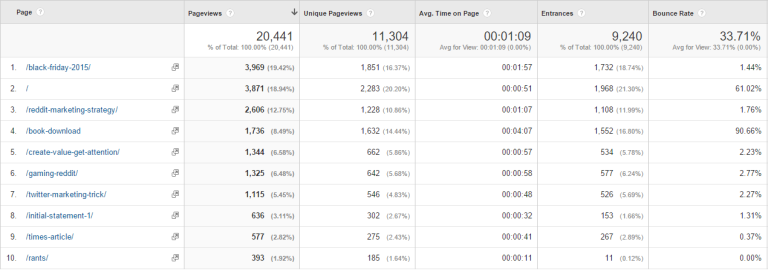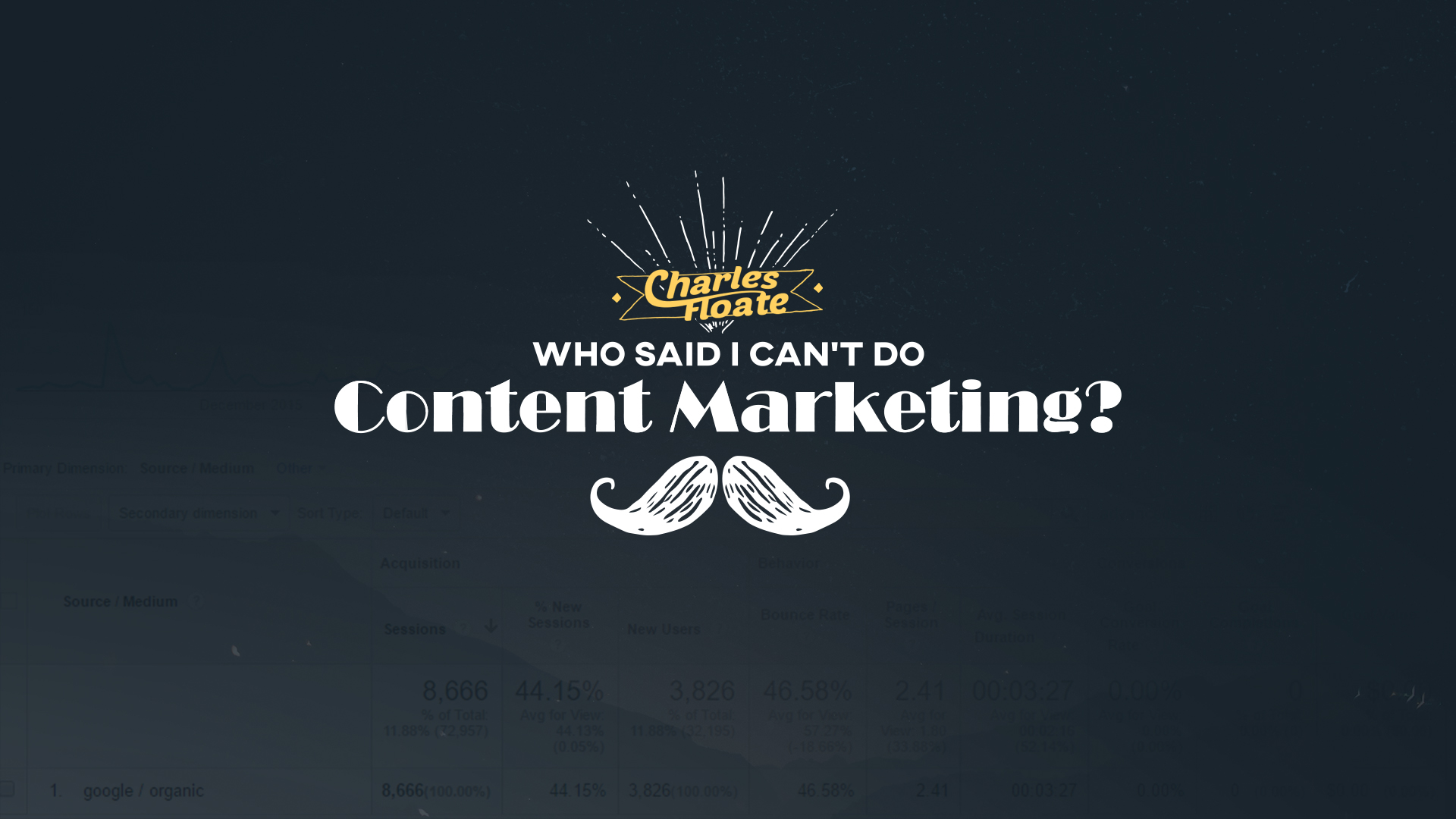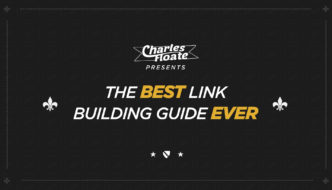When people who write about me in their blog posts, or interviews or just decide to talk about me to people. They tend to always resonate with me being JUST a black hat, sometimes grey.. but 90% of the time I get called a Black Hat SEO.
The argument has always come back around when people look at this blog though, because it’s so damn white hat – Huge content pieces, great OnPage, good user experience, no link building work, social/content promotion etc… You can call me a black hat all day long, but I’ve likely done a better job of white hat on this site than most “white hats” will ever manage to achieve in a lifetime’s work of tweeting about penalized link networks and Google “hinting” at algo changes or SSL’s being the epitome of current ranking signals.
Though I have owned this blog and wrote on it for several years now, it was only in late October of 2015 that I swapped my branding around and started using this site as my hub for my main blogging activities.
When my first SEO/IM related post came out in October 2015, I’d perhaps get a 100 unique visitors from search in a month… In a mere 6 months, I’m now doing 100 per DAY – And that’s with pure content, onsite and promotion. I haven’t done a single guest post, done any kind of broken link building or pretty much any “white hat” (or any other hat for that matter) type of link building… I’ve even been negative SEO’d (more than once) and I’m still gaining rank like there’s no damn tomorrow.
This post/guide/case study is going to be showing you how I took this site from 0 to 100 organic visits per day in a matter of months, and how you can do the same. Including all other traffic sources, my site now does about 500 visits per day, organic takes up about 20% of my overall traffic but social is a big part of it, so though there’s been no direct correlation between ranking and social signals, I’ve included a small part on my social campaign anyway, as I do think it’s a trust signal.
Note: Before I get into the rest of the post, if I’d done this in bigger niches (as SEO/IM is a fairly small niche in terms of monthly searches) I’d be likely at over 1,000 visits a month and not 100. The search volume for SEO keywords is fairly small, and as my domain is on a UK TLD, I tend to rank a lot better for keywords in Google UK than I do in the States or any other Google TLD. That isn’t a complaint, it’s a bonus for me as I’m British born and bred, my target audience is ideally in the UK, at the end of the day… Though if you aren’t from the UK and you’re reading this, I appreciate you being a reader just as much as anyone else!
So, without further ado… Let’s get into it.
Table of Contents
The 6 Month Strategy
My overall thoughts behind building this blog was to build a complete guide for beginners to advanced users in which they can learn SEO from start to finish with creative and unbiased tactics, as well as having information on various other internet marketing techniques/tactics/strategies that I implement myself… Yes, I am SEO-focused, but every great SEO will tell you they have a wide variety of skills that reach far and beyond just ranking in Google.
I wanted to put out laser focused OnPage targeted at specific keywords that had low competition, medium search volume but would be hyper-targeted at the kind of people I wanted to get onto the blog, as some examples, I’ve managed to achieve the following rankings in Google UK:
- #1 – SAPE Links (as well as “sape backlinks” & “how to buy sape backlinks”)
- #6 – Black Hat World
- #7 – SAPE
- #10 – How to build a PBN (as well as various other related KWs, going from page #1 – page #2)
- #3 – Parasite SEO (As well as my eBook being #1 & a forum thread I created at #2)
And a ton of other keywords as well. All of these keywords had specific posts or pages created to go after them, as they’re highly targeted at my audience. Before creating these pieces, I would analyse the other pages in those SERPs and try to out-content them, so that I’d have a lot easier time when it came to ranking them.
Now for a month by month break down of my activities… If you’re interested in the content I put out, then I suggest bookmarking some of the posts I mention in here, as you likely haven’t read all of them – And if you have, then you can read the rest of this post to make up for it!
Month #1 – November
My first post was actually on October 28th, but it was just a small piece and I didn’t really get back into blogging until November… So that’s where this story (ugh, I mean strategy) begins.
I mainly wanted November to be about getting my blog in good shape, putting out a good amount of starting content and trying to be featured in as many places as possible – Because relevance is key, and having people search your name helps create a brand in the long run.. I needed to get people who perhaps used to know me, or didn’t know me before seeing me everywhere.
I did interviews for podcasts, newspapers and radio stations.. Getting as much media attention as possible, because Traffic Leaks works, period.
I also had the most perfect timing around, as Black Friday had just come up and in the internet marketing world, black friday & cyber monday are big business, as proven by the nearly 4,000 pageviews my post on it got –

I also asked my Facebook Group what they’d like to see (in terms of content on my new blog) and social media tips & tricks were the overwhelming favorite… So I went to work smashing out a HUGE Reddit guide and some Twitter trickery as well. Give your audience what they want, and they’ll share you in the long run – Which is what I said in my first blog post back.
November Traffic Stats –
Visitors: 9,341
Unique Visitors: 6,033
Pageviews: 20,441
Organic Visits: 580
The hype around my return helped a lot, and the perfect timing of black Friday mixed with me sharing the black Friday post in every Facebook group, forum, sub-reddit and Skype group I could find someone asking for IM/SEO related deals on made for a killer amount of traffic… Even if the comment count was fairly low, my low affiliate link count and depth still converted over 100 newsletter subs in a matter of days.
Month #2 – December
December was the month where I wanted to start upgrading my content game… Getting pieces out that’ll generate traffic for months in to the future, and that they did… It resulted in my highest pageview count so far, over 33,100!
I tried to post at least 2 times a week in December, with pieces that were huge. I took time off building my affiliate sites, doing consulting work and hid myself away for the Christmas break to concentrate on blistering my fingers with the amount of content I was pumping out every day.
I also changed the design of the blog to this new, snazzy custom Genesis design and said a final farewell to the God of SEO brand.
Every other IM/SEO blog has a toolbox post, but I wanted to make one without the affiliate links so that people could get a complete unbiased opinion of tools and software I use on a daily basis. So I created the biggest list out there… December also saw my How to build a PBN post go live and several other large pieces, including my 2015 SEO Survey which got a TON of traffic from SEO forums in multiple languages, big shout out to the Thai SEO boards for the most traffic though!
I also released my infamous SAPE post on New Years Eve, which has since become the #1 resource for people wanting to learn SAPE in and out.
I put out so much content in December… Here’s some more highlights:
- My OnPage SEO Audit
- How I’m So Productive
- Facebook Competitor Attack
- SEO Who Does A Different Job Every 3 Months
It paid off though, as you’ll see by these stats.
December Traffic Stats –
Visitors: 16,088
Unique Visitors: 8,127
Pageviews: 33,156
Organic Visits: 755
December was also the month that I made most of my OnPage changes and implementations, but we’ll get to that in the OnPage section of this guide.
Month #3 – January
January was the month in which I started doing the master content technique, analyzing my fellow SEO/IM bloggers and finding what content was getting them the most traffic, so that I could optimize current, future and past posts & pages on the site to get the most traffic possible from organic.
I decided to push out posts on Silo Structure & Keyword Research to gain organic traffic and I knew my audience would appreciate both… I also put out a post on Entrepreneurial depression & Facebook marketing, both of which had fairly low competition in the SERPs, but were more targeted at my audience.
January was also the month in which I decided to just publish content on my blog, no guest posts at all and do as little features as possible – Only doing interviews or podcast features for BlackHat.Community and very rarely a few other productions by friends of mine and my audience. I did engage with communities, posting mini-guides on forums or social networks, but that was to get my face in front of new readers and help grow my brand even more.
January Traffic Stats –
Visitors: 10,197
Unique Visitors: 5,452
Pageviews: 17,716
Organic Visits: 1,261
January saw a slight drop at the start in organic traffic because I changed my permalinks, changed the entire design of the site and made a ton of other OnPage changes… Though by the end of the month, I was quickly shooting up the rankings and my traffic almost doubled in comparison to December.
Month #4 – February
February was the month I wanted to scale back the amount of content I was putting out, as the site had been filled with enough info to start on anyway, and start focusing on the single, very big pieces of content but at a lot slower rate than in months like January and December.
It’s also the month that I decided (I didn’t update a lot of you on this) not to do my traffic reports anymore, as it was a responsibility I couldn’t maintain.. Having to create a blog post within the first 3 days of a month can be rather damaging to your other work, as you HAVE to get that out. They got decent traffic, but low engagement.. Probably because I wasn’t flashing the cash like every other income report on the internet.
I’d pre-written several posts in January ready for February as I knew I wanted to work more on my organic traffic gains, so I managed to put out my local SEO post, a post that saw quite a large discussion going on in the comments section on realism and a few other posts including my Wikipedia backlink tutorial and my OnPage SEO guide.
February Traffic Stats –
Visitors: 13,603
Unique Visitors: 6,969
Pageviews: 22,148
Organic Visits: 1,704
I managed to stack another 500 visits in March. I saw a good increase by formatting my menus into smaller wording options, as to not take up more than a single line when you hover over them. It’s more for style points but the smaller amount of links in your nav bar, the better.
Month #5 – March
I released my course in March and as such spent most of my time working on finishing & promoting that, rather than writing for this blog… As the course now totals over 60,000 words, I didn’t want to spend another 15 hours writing a ton of posts for my blog.
Overall because of that release (which went very well, selling so far over 200 copies) I did a very limited amount of work on my blog and didn’t only put out 2 blog posts, those being my HUGE presentation on SEO in 2016 and my Client SEO rant which sparked yet another debate in the comments.
March Traffic Stats –
Visitors: 13,603
Unique Visitors: 6,969
Pageviews: 22,148
Organic Visits: 1,956
Due to my lack of work and releases on the blog, my organic traffic only saw a slight jump gaining just over 200 visitors. I believe that this is further proof of Google’s freshness algo though, as the traffic and rankings always get better the most posts that come out – I realize it could be argued that those new pages are gaining traffic, but it seems most of the posts or pages I put out take a few weeks to start gaining a significant placement in the SERPs and not just dancing all over the shop.
Month #6 – April
April was my perfect month, the month I want to showcase as the biggest advancement of my 6 month plan so far – I released 3 posts, 1 of which was nearly 10,000 words and the other 2 were both over 2.5k. This is the kind of content, and release schedule I think is the most suitable for a personal (or one man band) blog, that is if you want to get the most out of organic traffic.
The 3 posts I put out were my scraping tutorial, my MONSTER link building guide and my black hat world case study… All 3 of which have started immediately ranking for their respective keywords, which shows the power of a long term content marketing strategy in Google, though as you can see.. It didn’t come without a LOT of work.
April Traffic Stats –
Visitors: 13,603
Unique Visitors: 6,969
Pageviews: 22,148
Organic Visits: 2,550
Aprils 600 visitor leap is just the tip of the iceberg for what this strategy will achieve in the very near future.. Looking at Matthew Woodward’s blog as a fantastic example, he’s had 5 years to put everything together which has resulted in his ability to get over 33,000 organics a month… I’ve had 6 months and I’m at just over 7% of what he manages to get but my post count and site is significantly smaller than Matt’s and given another 12 months I reckon I could rival even his numbers.
The Final Results
After 6 months of creating content, optimizing the site, not building a single link and doing as much content promotion as possible… I managed to take the site from 100 visits per month to over 2,500 –

Considering I invest around 10 – 15 hours per week into this site, that’s some pretty good organic traffic… So far it’s only going upwards and my 10k/mo goal can be achieved by the end of this year.
Now that I’ve covered the specifics of my strategy and my month by month timeline and visitor numbers, let’s get into the specifics of how I went about actually getting these visits.
Content Creation
I have a minimum word count of 800 words, with the ideal blog post realistically being over 3,000 words… Normally posts with 2,400+ rank highest in Google (from mine and others testing), so I knew I wanted to crush that with every “targeted” post I put out.
My content creation is simple:
- I find a topic I haven’t yet covered OR I think could be covered in a better way.
- I do research into it, see what other people have done on the topic (for example in my Link Building post I found similar posts by Matthew Barby, Jon Cooper and a few others) and see their word count, formatting etc…
- I compare the current posts to see which was the most successful (links, social shares & comments) then base my post off the most successful one.
- I write the initial introduction (which is likely going to be edited later on) and then format my headings for how I want to go about writing the blog post.
- I then fill out the first paragraph of each header I’ve made, so that I can get an idea of how I want to write the rest of each section, and also add in any sub-headers for each one, as well – It’s likely I’ll add more headers and sub-headers as I write the post.
- I have my designer make any necessary graphics, and I make any videos that are attached to the post.
- Then I write it, until I’m happy with the post.
- I finally review the entire thing via the preview tool, then read the post inside the WordPress editor for any spelling/grammatical errors I’ve made.
I know a LOT of people like writing in Word, but I write within the WordPress editor as I prefer being able to see how the post comes out in front of my eyes, not how it appears in Word.
Design & User Experience
I took my blog’s design from a mixture of what I wanted the colour scheme to be and inspiration from several other successful blogs including Zac Johnson, Matt Woodward, Digital Marketer and several others.
I knew I wanted to use Genesis, as it has the fastest loading times when it comes to WordPress themes and it’s got a ton of very easy integration. My developer is also a dab-hand with Genesis, and after going through all of the themes available for it, I went with Metro Pro and had my designer start mocking up exactly what I wanted it to look like.
The black and red colour scheme the theme comes in by default was good anyway, as it matched my new logo and the artwork I had made for my Marketing Warfare eBook.
Navigation Menu
The most important part of the design for me when it comes to a blog is the navigation bar… I need to be able to let people get to the most important pages around my site, with minimal room used.
I’ve used the default theme’s navigation bar as it works really well in mobile and matches the rest of the site. I simply make each drop down as short as possible – Preferably going with 1 or 2 words on the first level of the menu, then going with 1 word for each option underneath, so that I only have 1 line length of options when desktop users hover over the menu.
Sidebar
My sidebar is where I aim to lower my bounce rate as much as possible – The about me is just for first time readers of the blog landing on to it and getting to know a little more about me.
The popular posts part is where the main lower bounce rate comes from, with people clicking through to more posts on the site – I sort this via comment count, and use the Genesis featured posts section. I use my featured images, date and author name rather than going with the title as the featured image looks better than just a title.
The email box is to convert readers into email subscribers, though the book banner ad converts a lot higher than that signup box does. This is down to the “Lead Magnet” style of email marketing I’ve been employing for a number of years.
The Facebook box is an attempt to convert visitors to likes on site, which (kind of) works with it getting around 10 – 20 new likes every week via that box.
OnPage Optimisation
However much white hats love to go on and on about great content gets you rankings, you can’t just write and rank in fairly competitive SERPs… And if I wasn’t going to have a ton of HQ links coming in from my own work, I knew I’d have to do some serious OnPage work to get the site up there – I also had to do it ALL white hat, no cloaking, no trickery that I’m used to, it had to be legit.
These tactics are in no particular order, but some do have stronger affects than other… For example the meta data & permalinks would have a lot more effect than the load time would.
Meta Data & Permalinks
The SEO plugin of choice I use is Yoast SEO, it’s totally free and I’ve used it for over 6 years now.
Note: You can find out my complete, advanced setup in my WordPress SEO eBook.
My meta data is keyword targeted with surrounding wording to make the titles and descriptions look natural. I also use a plugin called WP Social SEO Pro to edit the title and description for social platforms like Facebook, Twitter & Google+ so that I can use different headlines for social shares as compared to what I want Google to see.
My permalinks are very simple, if you’re using WordPress simply go to Settings > Permalinks and select “Custom Structure” then insert:
/%postname%
This makes your URLs the name of the page and removes the trailing slash from the end of every page, which I based on several other blogs in the industry as they were doing the same. This doesn’t have any direct ranking attributes, but it looks prettier when you skip forward to things as you don’t have a hashtag after the trailing slash, rather you just have the words.
Load Time
Though there is no direct correlation between load time and ranking, it doesn’t hurt to have a site that loads ridiculously quickly.
Granted, my server is rather overkill – It’s the top of the range KVM SSD VPS from RAMNode, which can take front page of Reddit levels of traffic but currently just hosts this site, my course and the God of SEO archive.
Genesis, which is the WordPress platform I run my blog on is also one of the fastest themes around. I also run MaxCDN on my imagery to make sure they load quicker around the world and several other plugins for file, CSS, HTML & other “shrinkers” or compression plugins.
Interlinking
As this is a white hat campaign, I do all my interlinking naturally – I just insert links where I think people could click through and learn more about something that I’ve already written about.
This is more LSI-based SEO though, as a lot of the time the anchor text I’m using isn’t what I actually want to rank for, though it is a long tail or a variation of the target keyword – This means Google can pick up on it, though it won’t have a huge effect on the direct ranking of that page, it helps spread juice and traffic around the site, the latter of which helps lower your bounce rate, which has seen very positive results from recent case studies and tests.
Content & Site Structure
You may of noticed at the top of a lot of my posts I use a table of contents, this is structured data very similar to how Wikipedia structures their tables of contents. This not only helps readers skip around, but also allows specific sub-sets of my content to rank higher for keywords, as it’ll show a “Jump To” in the SERPs, like so –

My site structure is based on trying to rank the posts themselves, rather than trying to rank the homepage or category pages etc.. I actually block Google from indexing my category pages, the only reason they’re there is for my readers to be able to quickly see more content from that category and to enable breadcrumbs in the SERPs, so my permalinks look like this –

This show’s Google what category to put my posts in and looks aesthetically pleasing in the SERPs.
For the table of contents I use this plugin, and Yoast has built-in breadcrumb settings to setup the latter.
Social Marketing
As I said at the start of this post, social is a big part of my content marketing strategy and even though it doesn’t necessarily play a direct role in ranking my site… I still wanted to cover how I go about it, as I’m sure a lot of wannabe bloggers will be very interested in my methodology – Which is actually pretty straight forward.
I’ve already wrote a pretty detailed guide on how I got about marketing on Facebook, so no need to completely repeat myself, a quick overview however:
- My Facebook Group – You get the most reach via a Group, due to Facebook’s stupid algo.
- My Fan Page – More for “show” I also get between 300 – 1.5k reach due to the highly interested readership on my page, with under 5,000 likes.
- My Personal Account – This is more for video, quotes and personal things, but I’ve still amassed nearly 1.5k followers.
The above list is in order of how important I deem each part of my Facebook marketing part to be. If you haven’t setup a Facebook Group for your blog yet, then you shouldn’t even be thinking about your Page right now.
YouTube
I’ve published several videos and series on YouTube in an attempt to help my audience and get picked up in the YT search results and recommended video sidebar – This has resulted in a few thousand visits to my site over the last few months, and directly resulted in purchases of my products:

I optimize videos to come up via (and this is in order) –
- A Keyword Optimized Title, mixed with click bait
- Minimum 2 paragraph description
- Optimized tags, for search
- Optimized script, as YouTube’s captioning system helps you rank higher as well
I’m also working on a YouTube marketing guide, so this post will be updated once that is out as well.
It’s the dying social network and it’s still dying for me as well, I’ve been slowly lessening my role on Twitter for the past 2 years, moving over to Facebook & Forums as my main 2 social points… I still however share things on Twitter, normally via the Buffer app – Which I have a premium subscription for.
I’m working on a Twitter marketing guide that’ll be out very soon and I’ll make sure to update this post once I’ve got it out.
I mainly just use Twitter to reply to those @’ing me, to quickly share posts/news articles I have read (and enjoy) and share my own things – I still have a fairly decent following, though my reach isn’t what it used to be when I was more active on the site.
Other Social Networks
I talked about Buffer above, I don’t really maintain any of my other social network profiles such as LinkedIn or Google+, but I do add shares to my Buffer queue which is connected to those profiles – I get trickles of traffic from them, but as I don’t maintain them at all it’s not very interesting for me.
Retargeting
I recently put out a blog post on the basics of Retargeting, but I want to make my strategy even clearer when it comes to this site’s retargeting strategy.
Instead of finding a new audience via Ads, I wanted to retarget my audience that was already here and organic traffic makes up a BIG part of that. My organic traffic is about 45% NEW visitors, that’s a potential extra 1,125 new email subscribers every month that I can signup to my email newsletter, target my products at or just new blog posts/presentations.
I don’t use Twitter ads for retargeting, as Twitter ads is rather expensive and with a smaller user base than Facebook – Also Facebook’s Ads tend to convert a lot better. My Retargeting campaigns normally cost me around $0.08 per click, rather than around $0.20 – $0.50 if I were to do a standard campaign with a targeted audience. That’s a MASSIVE saving, and the traffic converts a lot better, as well.
Monetization
I love blogging, it’s a passion of mine… It’s very therapeutic, and can distract you from any problems you may have for hours on end. It’s also fun (and a little egotistical) to see everyone replying to a post in the comments or the almost instantaneous flood of traffic I get when a new blog post goes live.
However, I run a business, I have goals and ambitions and my blog is a very big part of them. I try to monetize it in the most efficient and least in your face way possible… By helping people (for free) to make money, and then helping them grow that income by offering paid products, mostly info-products that there’s limited information (or limited up-to date/good information) available on.
Affiliate
I’m not a huge fan of doing affiliate on this blog, my toolbox for example has no affiliate links and I only promote about 10 – 15 products in total across the site.
This is for a few reasons:
- I don’t actually use a whole heap of tools myself, and I only want to promote things I actually use and that would help other people. For example, I’m not a big believer in Long Tail Pro (or the million other keyword research tools with fat commissions attached) because I don’t use it.. I use a mixture of Google Keyword Planner, my own knowledge, suggestion tools and some competitor research tools like SEMRush.
- You have no control over the quality a user you refer gets – With your own products, you run the support, you make the product, you run the delivery etc etc.. If I refer someone to a service or provider through an affiliate link, I have a level of responsibility for that referral but don’t actually have any control over what the service/product will ever provide. I’ve had it blow up in my face before & actively did reviews against people promoting just for profit. So if I refer someone to a service/product, I better damn well be sure it’s going to go well.
- Affiliate money is never guaranteed. I’ve worked with a company that took 9 months to pay-out before, even though their TOS said 30 days… And there’s almost nothing you can do about it. I like guaranteed income, and affiliate isn’t all that guaranteed in this niche, especially.
I still make a reasonable amount off my affiliate income from this blog, but as it’s not my main focus what-so-ever.. I don’t make nearly as much as if it was.
Info-Products
I’ve only actually released 3 paid info-products so far, all of them have been rather big successes and in total I’ve probably made close to 6 figures profit, USD.
I try my hardest to make my info-products as unique as possible. My target audience is intermediate SEOs who want to take things to the next level, so I don’t put ANY fluff in my products nor do I aim to ever do so.
I also don’t do aggressive marketing for these products – I don’t spam it all over the place, or do 100 webinars a year… I just do Retargeting, banners on my blog and a few other blogs and send it to my email list. That’s it.
Consulting
At the start of this blog I put a lot of time into promoting my consulting services and as I’ve grown my blog, audience and other products over time I’ve started to stray away from it more and more. I do still offer consulting services, I’ve just slowed down my work rate when it comes to them.
This is for a very simple reason – When I first started this blog, I didn’t have the levels of cash I do now.
I needed capital to invest in my passive projects, products for this site and the site itself and various other things as well, such as my recent acquisition of Comment Monster.
I had the knowledge, the experience and the ability to test that a lot of other people in the industry do not have, and as such, I was a very easy pick-up for many people wanting to speak to someone on both the white and black hat sides of things.
Within the first 3 months of launching my consulting services (first under the GoS Brand, and quickly changing it to this site) I’d delivered over 150 hours of sessions or IRL consultations. That gave me the pure profit capital I needed to re-launch old sites, and launch new sites in my affiliate game.. Which turned that setup capital into a 5 figure a month, almost-passive business.
“Link Building”
As I said, I didn’t directly do any kind of link building work on this site and the main way I got links to it was by people naturally sharing my content on their site or blog. Which has increased my authority a lot.
However, I knew I needed some links at the beginning to get things off the ground, and as such I started using some clever content marketing tactics to gain some links – I’m not talking about stupid guest posts or out-dated broken link building, this is actual content marketing style link building… Not just what some agency has told you about.
My Facebook Ads Method
One of the best ways I got initial links to my blog was by targeting specific posts at bloggers via Facebook Ads – If you can help them with their SEO, then a lot of these people will featured you in their top lists or monthly reports on how they improved their blog – Which, as it turned out.. They did, a lot.
I spent $30/day on Ads targeting UK, US, Canada, Australia and New Zealand based people aged between 22 and 50 that had “blogger” “writer” “copywriter” and various other online writing related job names in their job title – This resulted in around 650 total clicks and I spent about $1,000, across 8 blog posts. There isn’t a direct way to track the amount of links I got back from doing this, though I can showcase at least 14 (as a lot of them emailed me) that I found from using this… That’s a minimum 14 referring domains!
Kiss A$$
It’s still one of the very best ways of getting links, social shares and your face in front of the right audience. Though I’ve only done this method ONCE on this blog, it managed to get a very decent amount of visits from the people I mentioned sharing this post:
Though the post itself got no direct links back, I know several of the people featured (such as Mr Green and Ryan Stewart) have since linked back to my work as a result of me throwing myself in-front of them and… Kissing A$$!
All Them NoFollow Links!
The one link building tactic I suppose I have used is building NoFollow links… However, I haven’t been building them to build links, it’s more because I actually want the link to be there.
For example, every YouTube video that has a link back to my site on is a NoFollow link – The point of that link being there is to send traffic to the target page, it’s not there for the purpose of being a link.
Likewise, every time I comment on a blog post (that doesn’t have Disqus or some other non-website submitting commenting system) I get a NoFollow backlink to my blog. Blog commenting has always been one of my favourite methods of building links, but to this blog, it’s purely because I want to comment on a conversation.. Not just build a link.
P.S.
If you’d like to find out how I actually go about link building on every other site but this one, then check out my HUGE link building guide here.
Thanks For Reading
I hope you enjoyed this post, I know I’ve been smashing out the huge pieces recently and if you’re a returning visitor but haven’t joined my email newsletter yet then you can do so below, you’ll get a free 7 day SEO course out of it as well.
Don’t forget to leave a comment with your thoughts on white hat SEO and this specific case study as well.
- Charles
P.S.
Would you like to see another post like this one in 6 months time? I’m aiming to hit my goal of 10,000 organic visits a month by then.
P.P.S.
This post proves that I can do content marketing, because you’re reading it right now.








